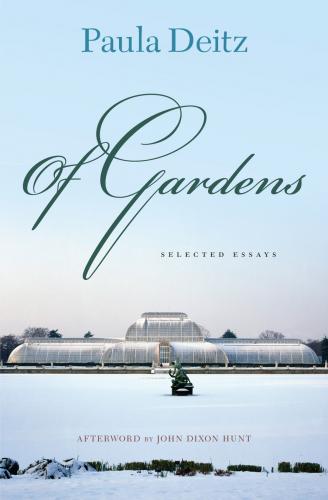The Poetics of the American Garden
1680 Formal Garden Discovered in the South
A Historic Colonial Plantation Recovered from the Rough
Fairsted: At Home with Frederick Law Olmsted
At Old Westbury, Gracious Gardens
Stately Views: A 1920s Garden Inspired by the Villa d'Este
Mediterranean Light: A Classic Italian Garden in California
Wethersfield: In the Style of an Italian Villa Garden
The American Academy in Rome
The Abby Aldrich Rockefeller Garden: A Blend of Far Eastern and English Inspiration
Far East, Down East: A Classic Asian Landscape
A Cultivated Coast: The Garden at Somes Meadow
On Maine's Coast, Vistas Are Cast in Stone
Autumn in New England
The Painted Garden: William Kent's Rousham
Painshill Park: Charles Hamilton's Folly Garden
The Waterways of Castle Howard
Reclaiming Noble Gardens of the Towy Valley
Classic Garden Tames a Fierce Welsh Crag: Powis Castle
Buckhurst Park: From Humphry Repton to Edwin Lutyens and Gertrude Jekyll
Lanning Roper's English Gardens with a U.S. Flavor
Machine in the Garden: Charles Jencks's Garden of Scottish Worthies
Sitting in the Garden: A History
The Gardens of Versailles
An Echo of a Memory: Recultivating the Tuileries
The Formal Farm: Pascal Cribier's Vision of Rural Geometry
The Désert de Retz: Cultural History Through Architecture
Autumn in Japan
Japanese Screens and the Gardens of Kyoto
Balancing Act: A Contemporary Garden for Kyoto's Oldest House
Tea and Empathy: The Japanese House, Shofuso, in Fairmount Park
Rice Paddy in the Sky: Rooftop Garden at the Mori Center
Plum Blossoms: The Third Friend of Winter
Courson: French International Flower Sale
At Chelsea Flower Show: Gardens in Romantic Ruins
Free to Grow Bluebells in England: British Prisoners Win Gold Medal
A Garden Festival in Lausanne
Epilogue. A Winter Garden of Yellow
…nothing to the true pleasure of a garden.
—Francis Bacon, “Of Gardens,” 1625
IN 1625, the British philosopher and empiricist Francis Bacon wrote in his seminal essay “Of Gardens” that without gardens “buildings and palaces are but gross handiworks,” and that even “when ages grow to civility and elegancy, men come to build stately sooner than to garden finely; as if gardening were the greater perfection.” As I reread this passage recently, my mind harkened back to the experience that jolted me into understanding landscape architecture, not just as a stepsister to architecture, as Bacon partially implies, but as the means by which man redeems the natural environment through design. The occasion was a lecture by the landscape architect and ecologist Ian L. McHarg at Rockefeller University in New York City. He had just published his book Design with Nature, and that evening, along with his clarion call for environmental responsibility, he coined the concept of “the reassuring landscape,” defined as cherished scenes from childhood that we continually seek out or recreate later in life. This lecture struck a chord in me and eventually became the taproot of this book. McHarg was a founder of the Department of Landscape Architecture and Regional Planning at the University of Pennsylvania, and therefore it is a singular privilege for me that John Dixon Hunt, Professor of the History and Theory of Landscape Architecture in that department, selected this collection for the Penn Studies in Landscape Architecture, of which he is the inaugural series editor.
Three years after McHarg's lecture, the Whitney Museum of American Art presented the exhibition “Frederick Law Olmsted's New York.” At the entrance to this show was a map of the United States with Olmsted's landscape designs pinpointed across it. Standing there I realized that my entire young life, with the exception of my college junior year abroad in Geneva, Switzerland, had been circumscribed by Olmsted's pastoral landscapes. I was raised in Trenton, New Jersey, where Cadwalader Park, with its bucolic hills and dales, was the focus of recreational and cultural events (sledding the best of all), followed by Smith College, where Olmsted designed the entire campus as a botanic garden and arboretum, with every tree and plant labeled. And finally, I settled in New York City, where I live two blocks from Central Park and walk its paths regularly. The American landscape, as I knew it, was derived from the eighteenth-century picturesque parks and gardens Olmsted had visited in England and recreated on native soil.
During the six weeks that the Smith College Geneva group spent in Paris my year, before the term began at the University of Geneva, Versailles topped the list of our orientation activities. I still have the class photograph documenting the unforgettable visit that gave us our first view of André Le Nôtre's gardens. Until then, nothing in my life had prepared me for the classical grandeur and geometric precision of those seemingly endless parterres, bosquets, fountains, and statuary set among topiary and clipped trees. Like Ian McHarg in his book, I was enthralled with the snow-capped Alpine scenery of Switzerland during the subsequent year as well as with the local farm villages, wildflower fields in spring, and vineyards cascading down mountains. But the rigorous beauty of Le Nôtre's designs became the lasting touchstone for me, linking gardens with history as well as nature. What had prepared me to understand this linkage was a lecture in European intellectual history at Smith presented during the preceding year by Elisabeth Koffka. She gave an account of the bridge between
